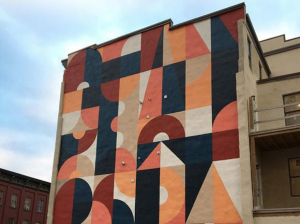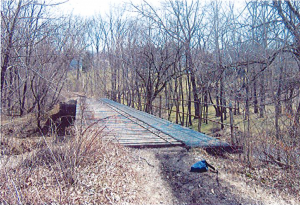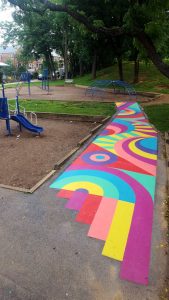Within the curriculum, the framework for two project options has been generated. The generation of these two options was done to show what contexts, values, and guidelines all proposed projects should encompass. It is important to consider that even though we are proposing two specific projects, there are many more possible ideas, some of which we explored that could also accomplish our goals. Some of these ideas include exposing art pieces around the campus of Lafayette College or the Karl Stirner Arts Trail. If the future students working on this project decide that they want to head in this direction, there are a few technicalities they must address, which also apply to our two proposed projects. The two proposed projects involve repurposing an abandoned bridge trestle and creating murals around the greater Easton area. The structural analysis has been completed for the abandoned bridge trestle while the murals option will be accomplished with the help of the Easton Mural Project. By both projects leveraging the framework already built for them, the technical context of each project will become more transparent, putting less of a burden on the project group.
Both of the two proposed projects have a different technical context. Each project requires different tools, supplies, and even human capital. For example, the railroad trestle project specifically required a civil engineer to complete a structural analysis, whereas the mural project did not necessarily require one. A benefit of having multiple projects, each with a different technical focus, is that students have the ability to choose which one they want to work on and furthermore, they can contribute their expertise or learn about something new. Generally, most art students would not have exposure to working with engineers to inspect for the structural integrity of a railroad trestle, and on the other hand most engineers would not have the experience in their engineering education to use their problem-solving skills to create a mural or public art piece.
Before the design process even begins, it is necessary to determine where the piece of art will be installed, mainly because the design process must take into account the amount of space it is given for such art piece. Additionally, depending on the location, certain considerations may need to be made. For example, if the art will be installed outside, it must be a medium which can withstand the conditions it will be placed in. The Karl Stirner Arts Trail has a special arts advisory council, which must approve of the artwork before it is placed in the trail (Art and Nature Converge). Therefore, students will need to work with council members to determine both where they will be able to place their creations, how big they can be, and most importantly what they are. This is also true for any of the other three locations proposed, as each has a different governing body that will determine the location and size specifics of each art piece.
If instead the art pieces or murals are to be displayed at Lafayette, our communications with professor Mary Wilford-Hunt, director of the college’s facilities planning and construction, might prove useful. We found that in order to display student created artwork on campus, it is necessary that a robust plan including how the art piece will be maintained over time and a specific budget for it must be submitted for review (Wilford-Hunt, 2018). Thus, not only for Lafayette but all four locations, students in the design phase will also need to assess their creation’s maintenance needs and create a comprehensive budget plan for it.
The maintenance needs and budget plan will depend on how long the art is exposed, the materials used, and a multitude of other factors depending on the individual project. Chaz Hampton stated that public art and murals in Easton are built to have a minimum lifespan of 10 years. This guideline will be implemented into all projects, deeming it necessary that all works of art produced from this curriculum are built to last at least 10 years. This is not to say that the art will be required to stay at its location or on public display for 10 years. Lifespan, maintenance, and a budget plan is needed as soon as possible in the design process, so that students can plan accordingly on which materials they will use in their specific projects. As with the location and size aspect, governing bodies of each of the four locations will need to be consulted. The Karl Stirner Arts Trail has several art pieces that are placed indefinitely, but also art expositions that are seasonal, such as the ones on the Young Masters Wall (Art and Nature Converge). Future students will need to work closely with the board members and maintain an open line of communication to ensure the installations are occurring in the correct location depending on the art piece.
One technicality that all projects share is that they all require students from the arts and engineering to collaborate. We propose that this is initially done by either meshing these projects with an existing course or by creating a totally new interdisciplinary course between the two departments. If such projects are successful, creating an entity on campus to hold these projects and expand them college-wide, such as the Dyer Center for Innovation and Entrepreneurship was created to foster a culture of innovation at Lafayette (Dyer Center Lafayette College), could be sought after.
The creation of a new course was explored before by another EGRS capstone project form the fall of 2013, the Sports and Engineering Seminar project (Lantz, K., & Tuttle, K.). They delineate that in order to achieve the status of course at Lafayette, a course proposal form must be submitted within the college administration. But before that, all the course specifics must be determined, and a syllabus created, including course objectives, learning outcomes, grading policy, an academic honesty statement, course bibliography/reading list, and a federal credit hour compliance statement.
Proposed Project 1: Student Murals
The Student Murals project proposes that students, in conjunction with professors and community members, design and mount murals highlighting the Easton’s technological and industrial past around the city, the Silk Mill complex and the campus of Lafayette college. As with the other proposed projects, in order to achieve this objective, students from both the engineering and art departments will need to work together to tackle design and artistic problems as well as several technical challenges. Since the art pieces themselves are idealized to highlight Easton’s industrial history, the initial idea is to have engineering students research and choose which artifacts and/or locations they want to depict in the art murals. Art students will then be tasked with creatively designing and later painting the murals themselves.
This project aims to work together with the Easton Murals Project (EMP), a collaboration between the owners of the Brick + Mortar Art Gallery and the Easton Main Street Initiative (Easton Mural Project.). The EMP’s initial target location for its murals is in Easton’s downtown area so that the art pieces are more visible to the public and the organization can further garnish attention and support for the project. An example of such work can be seen in Figure 4. This will in turn help the initiative secure funding in an easier manner, due to the increased awareness and approval. Since EMP’s inception in mid-2016, the group has successfully had artists paint 3 murals around downtown Easton with one wall waiting to be painted. The work done by their organization should be considered as an achievement by itself, but it also shows just how difficult it is to find suitable walls to paint murals over in Easton. Because our project aims to improve the town-gown relationship between Lafayette and Easton, the target locations for murals produced by this project should be similar to the EMP’s. Therefore, this is the biggest technical challenge this project will face.

Figure 4: Mural by Scott Albrecht in Easton, PA.
An alternative to exposing the murals in the downtown Easton is to choose uncommon locations around the county, as the industrial buildings themselves. Going down this path will require further participation of engineering students in the project to ensure the reliability of the walls being painted on. Engineered structures might even be needed to house such art murals.
At the time of writing this report, there is still one wall open for artist bids in the EMP website, at 133 North Fourth Street, Easton (Easton Mural Project). The proposed wall measures roughly 542.5 square feet in area, making it a mid-sized wall for a mural, something that should be considered within a cost and technical analysis. In working with the EMP, students would need to submit their designs as bids to the organization, as well as other documents such as estimated budgets and proposed mediums.
Since the portfolio option follows the idea that students will be painting the wall, no labor costs should be needed in this project. Because each art piece is uniquely created, there is no telling exactly which or how much of each material will be needed for this project. Students will need to evaluate how and with what materials they will complete their murals. It should be emphasized that high-quality materials should be preferred as it will increase the longevity of the mural which needs to be ten years minimum. The main materials needed will most likely be the paint and primer chosen, alongside with other such as brushes, stairs and equipment. However, murals can be abstract and main materials can vary. Costs of other materials, such as brushes, stairs and equipment should also be considered when analyzing the cost of murals. Chaz Hampton in particular will serve as the main figure from the community giving guidance on the mural option due to his expertise within murals and their implementation.

Figure 5: Proposed bike path on old bridge (View of upstream approach).

Figure 6: A painted pathway welcomes community members to a playground (Magic Carpet).
Next: Conclusion